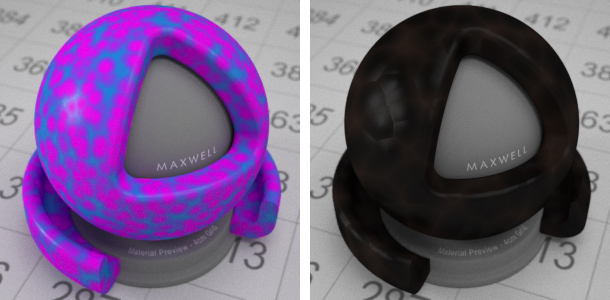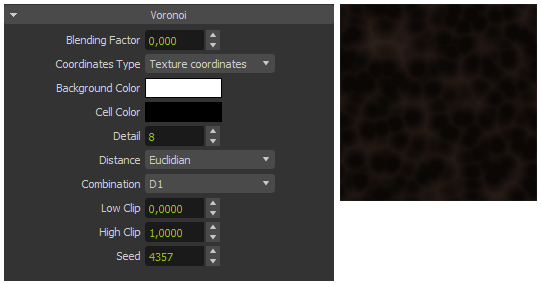Voronoi
Voronoi
The Voronoi Procedural creates a cell pattern where each region is defined to minimize the distance to certain random points. This pattern recreates the distribution of cells in organic tissues, skin squamas or land compartmentalization, where a number of individual random entities grow to occupy the maximum space. Useful as a color texture or in grey scale as a bump, displacement, weight map or mask texture.
Examples of the Voronoi procedural in use, both as color texture (left) and as bump texture (right)
Voronoi Procedural parameters
- Blending Factor: Blends a percentage of the current procedural with the result of the procedurals below in the stack.
- Coordinates Type: Chooses if the procedural will be created in object Texture coordinates or in World coordinates.
- Background and Cell Color: Defines the color used for the background and cell patterns. Uses black, white or grey tones when the pattern is used as a mask texture.
- Detail: Amount of detail produced by the procedural. It increases the size of the domain used to perform the computations.
- Distance measure: Type of measure used to compute the distance between two points in 2D. Options vary from Euclidian, Manhattan, Minkowski to Chebyshev distance definitions.
- Combination type: How the distance between points is combined to show the voronoi texture.
- Low Clip: The minimum value allowed, thus clamping the result computed by the procedural. Numerical values lower that this threshold will be assigned to the Background color.
- High Clip: Maximum clamping value allowed for that procedural, that will be assigned to the Noise color.
- Seed: Initial value used for the generation of random numbers computed by the noise procedural.
The Voronoi procedural parameters panel
A note on the Voronoi parameters
To know more about the different geometric distance definitions involved in the Voronoi distribution, see these links:
And to read more about the Voronoi distribution, see this link:
, multiple selections available,

